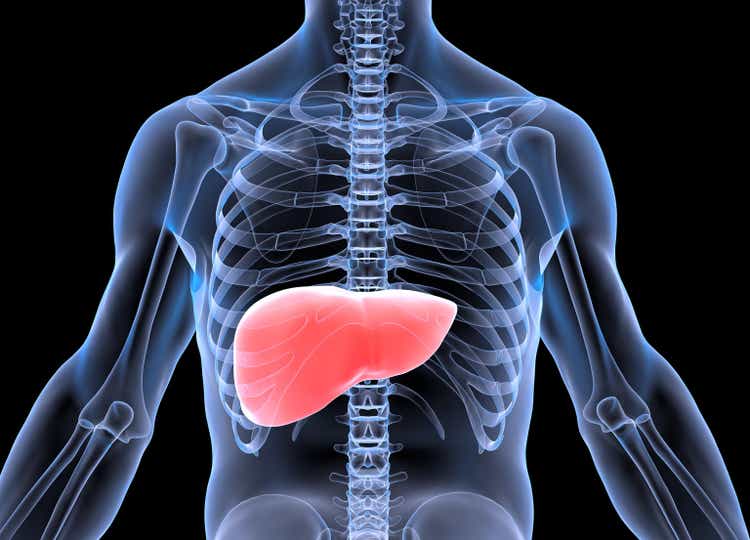Benito Vega
Akero Therapeutics, Inc. (NASDAQ:AKRO), which I have been accumulating on dips over the last 1.5 years, has had a tremendous spur in the last couple of days, buoyed by some strong data in a phase 2b NASH study. To be honest, I didn’t become a millionaire overnight with this – among other reasons, one is that my initial pilot buy last year, followed by a second doubling down this year, only managed to average it down to the high teens zone. However, I am still happy with the profits made, and happier still that there’s finally some progress in NASH. Biopharma, as I told my subscribers the other day, is back.
If you read my previous two coverages of AKRO – here and here – you can see how I was plenty bullish re this phase 2b trial. Akero’s NASH molecule is called Efruxifermin, an FGF21 analog, which is a crowded space. However, Efruxifermin has now been able to differentiate itself well from the pack. Its fibrosis data from an earlier phase 2a study was outstanding:
Of the 40 treatment responders who had end-of-treatment biopsies, it was observed that 48% achieved at least a one-stage improvement in fibrosis without worsening of NAFLD activity score (NAS) and 28% achieved at least a two-stage improvement in fibrosis. In addition, 48% of responders achieved NASH resolution with no worsening of fibrosis.
The company just recently announced the HARMONY phase 2b data. Data showed that Efruxifermin improved liver fibrosis without worsening liver disease. The trial evaluated two dose levels, 50 mg in 34 people and 28 mg in 38 people against placebo (in 41 people) in patients with pre-cirrhotic nonalcoholic steatohepatitis (NASH), fibrosis stage 2 or 3 (F2-F3). Key data:
The study met its primary goal for both the 50mg and 28mg EFX dose groups, with 41% and 39% of EFX-treated patients, respectively, seeing at least a one-stage improvement in liver fibrosis with no worsening of NASH by week 24, compared with 20% for the placebo group, the company said in a Sept. 13 press release.
The study also met a key secondary goal, with 76% of patients treated with 50 mg and 47% of those on 28 mg, achieving NASH resolution without worsening of fibrosis, compared to 15% for placebo, the company noted.
Akero added that 41% of patients on 50 mg and 29% on 28 mg, achieved both goals (NASH resolution and fibrosis improvement ≥1 stage), compared to 5% on placebo.
Despite indicators of more advanced disease, the study also showed statistically significant effects in multiple secondary goals in both dose groups, including improvements in liver fat, liver enzymes, non-invasive fibrosis markers, HbA1c (blood sugar level), lipoproteins, and body weight, according to the company.
I do not have details of the p-value for the primary endpoint, just that it was less than 0.05. However, Evaluate says the primary endpoint just “squeaked into” statistical significance, and if the company had included the discontinued patients in a proper analysis of the intent-to-treat population, that they might not have attained stat sig. (A total of five patients treated with EFX were discontinued due to AEs, two in the 28 mg group and three in the 50 mg group.)
However, this is nitpicking; ITT analysis is usually conservative in terms of treatment effect, and a modified ITT analysis, or mITT, for example, a per protocol ITT population assessment, would better represent the treatment effect in my opinion. This would be the population of all ITT patients who completed the trial per its protocol, and this would be a better assessment because including discontinuations – whether treatment-related or not – is a reflection, often, of the tolerability of the drug (in the former case) than of efficacy. Let’s not also forget that there were 6 patients who discontinued due to “administrative reasons,” and at least one patient in the drug arms who declined a second biopsy. This point is important because, as Akero points out in a conference call, most other NASH trials of its peers did not follow ITT, but only used data from those who did the second biopsy. That is understandable because if the primary endpoint assessment needs a second biopsy, and an ITT patient does not do it, what use is their data?
The company will report data from the phase 2b Symmetry trial in biopsy-confirmed Nash patients with compensated cirrhosis next year.
Financials
AKRO has a market cap of $461mn (this figure from SA seems low, YF shows $1.04bn) and a cash reserve of $180mn. They also have a $100mn debt facility from Hercules Capital. Pfizer (PFE) recently put in $25mn for a small stake in the company. After the positive data readout, the company just announced a $175mn secondary offering. With a burn rate of approximately $30mn, the company is set for quite a few quarters, in terms of cash.
Bottom Line
While the data is certainly good, Akero is in a tough field, as the failures of Gilead (GILD), CymaBay (CBAY) and Cirius (CSTX) have shown. Intercept, with the only approved drug, also got rejected, and both NGM (NGM) and Genfit (GNFT) failed their NASH trials. Madrigal (MDGL) is still the leader, and recently posted some data from one trial; however, it still needs to cross the bigger hurdle, efficacy data from the phase 3 trial, coming up this year. Given all of that, while AKRO’s data is impressive, investors need to be cautious, and not oversell their hands.


Be the first to comment